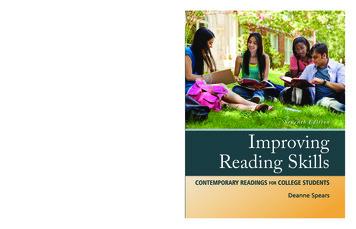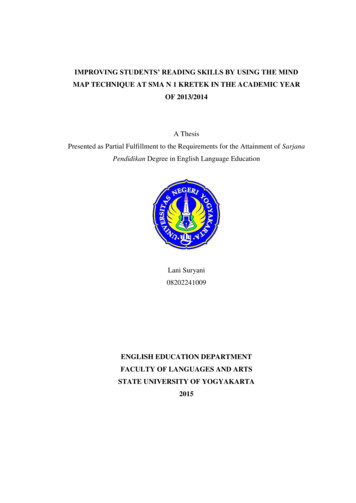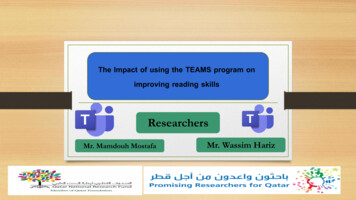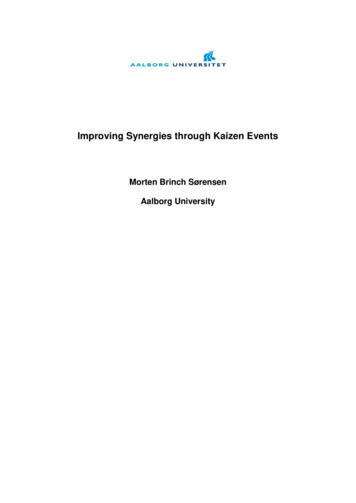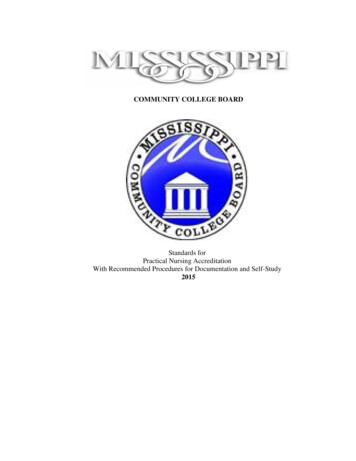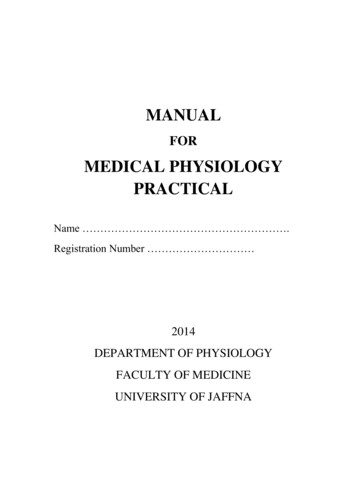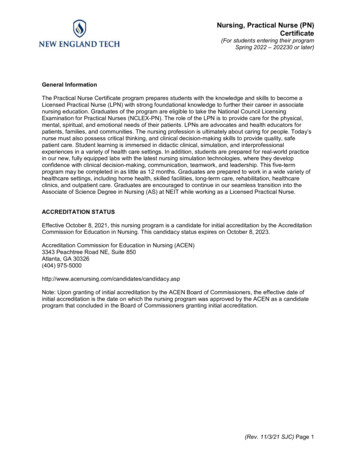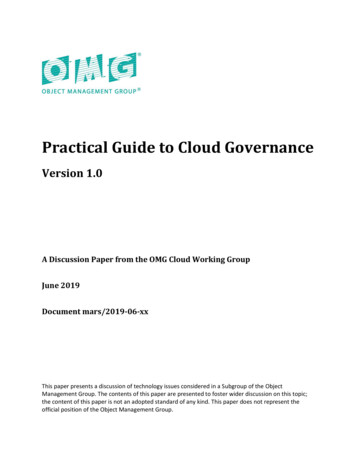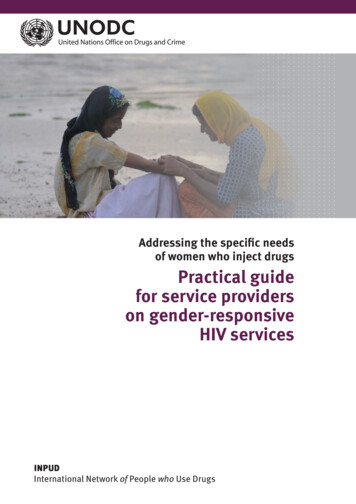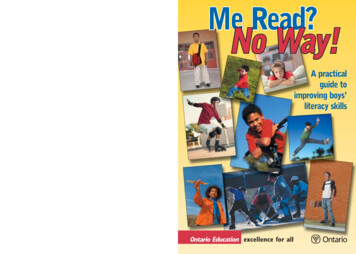
Transcription
Me Read?No Way!A practicalguide toimproving boys’literacy skillsPrinted on recycled paper Queen’s Printer for Ontario, 2004ISBN 0-7794-7014-104-068
ContentsAbout This Guide . . . . . . . . . . . . . . . . . . . . . . . . . . . . . . . . . . . . . . . . . . . . . . . . . . . . . . . . . 2Who the guide is for . . . . . . . . . . . . . . . . . . . . . . . . . . . . . . . . . . . . . . . . . . . . . . . . . . . . . 2What the guide contains . . . . . . . . . . . . . . . . . . . . . . . . . . . . . . . . . . . . . . . . . . . . . . . . . . 2How to use this guide . . . . . . . . . . . . . . . . . . . . . . . . . . . . . . . . . . . . . . . . . . . . . . . . . . . . 2Why Boys? . . . . . . . . . . . . . . . . . . . . . . . . . . . . . . . . . . . . . . . . . . . . . . . . . . . . . . . . . . . . . . 4What test scores tell us . . . . . . . . . . . . . . . . . . . . . . . . . . . . . . . . . . . . . . . . . . . . . . . . . . 4Towards a solution . . . . . . . . . . . . . . . . . . . . . . . . . . . . . . . . . . . . . . . . . . . . . . . . . . . . . . 5What about girls? . . . . . . . . . . . . . . . . . . . . . . . . . . . . . . . . . . . . . . . . . . . . . . . . . . . . . . . 6Taking gender differences into account in the classroom . . . . . . . . . . . . . . . . . . . . . . . . . . 6Strategies for Success . . . . . . . . . . . . . . . . . . . . . . . . . . . . . . . . . . . . . . . . . . . . . . . . . . . . . . 8Have the right stuff: Choosing appropriate classroom resources for boys . . . . . . . . . . . . . . . . 8Help make it a habit: Providing frequent opportunities to read and write . . . . . . . . . . . . . . . 12Teach with purpose: Understanding boys’ learning styles . . . . . . . . . . . . . . . . . . . . . . . . . . 15Embrace the arts: Using the arts to bring literacy to life . . . . . . . . . . . . . . . . . . . . . . . . . . 22Let them talk: Appealing to boys’ need for social interaction . . . . . . . . . . . . . . . . . . . . . . . . 26Find positive role models: Influencing boys’ attitudes through the use of role models . . . . . . 30Read between the lines: Bringing critical-literacy skills into the classroom . . . . . . . . . . . . . . 33Keep it real: Making reading and writing relevant to boys . . . . . . . . . . . . . . . . . . . . . . . . . . 37Get the Net: Using technology to get boys interested in literacy . . . . . . . . . . . . . . . . . . . . . 40Assess for success: Using appropriate assessment tools for boys . . . . . . . . . . . . . . . . . . . . . 43Be in their corner: The role of the teacher in boys’ literacy . . . . . . . . . . . . . . . . . . . . . . . . 46Drive the point home: Engaging parents in boys’ literacy . . . . . . . . . . . . . . . . . . . . . . . . . . 49Build a school-wide focus: Building literacy beyond the classroom . . . . . . . . . . . . . . . . . . . 52References and Resources for Further Reading . . . . . . . . . . . . . . . . . . . . . . . . . . . . . . . . . . 55This publication is available on the Ministry of Education’s website, at http://www.edu.gov.on.ca.ISBN 0-7794-7014-1 (Print)ISBN 0-7794-7415-X (Internet)1
About This GuideThis guide was prepared by the Ontario Ministry of Education as part of an initiative tosupport student success in literacy. In particular, it focuses on boys’ literacy.Based on an international review of effective practices, the guide is intended to stimulatediscussion of this important issue among educators in Ontario and to provide practical andeffective strategies that teachers across the province can put to use in the classroom, bothimmediately and over the longer term.Who the guide is forThis guide is intended for teachers, principals, and other professionals in the field ofeducation at the elementary or secondary level. It will be of particular interest to thosewho are developing and delivering literacy programs.What the guide containsThis guide offers a rich source of practices and strategies that are being used in successfulliteracy programs for boys around the world and that educators in Ontario can draw on tocreate a stimulating and engaging learning environment for both boys and girls. In this guide,you will find: supports, information, tips, and ideas conveniently organized into distinct categories; a wide variety of sources that you can refer to for more in-depth exploration ofparticular concepts or topics.How to use this guideThis guide is structured around thirteen “Strategies for Success”, which are listed in thetable of contents. These strategy sections attempt to distil for educators the most importantresearch on how boys learn to read and write and the most effective instructionalapproaches and strategies for helping boys enjoy learning to read and write well. Wesuggest that you review the list of “Strategies for Success” in the table of contents topinpoint those areas most relevant to your immediate needs, and read the rest as timepermits and need dictates. The guide is designed for browsing!2
About This GuideTo make the guide as useful and accessible as possible, the following four categories of information have been singled out for special treatment. Each section is signalled in the guide bymeans of the icon shown alongside each heading below.Quick factsBackground information and research findingsTry it now!Practical suggestions that you can implement quickly and easilyBest practicesEffective instructional strategies and approaches that you may wish to exploreInsightInsights from the literature about boys’ literacy development and literacyinstruction for boysA list of references and resources for further reading is provided at the end of the guide.3
Why Boys?All educators share the common goal of providing equitable learning opportunities for everystudent in the classroom. Providing equitable opportunities for girls is a familiar topic;providing them for boys is a relatively recent issue, but one that is appearing with increasingurgency on education agendas around the world. An increasing volume of evidence indicates that gender is a significant factor in bothchoice of reading materials and reading achievement for boys and girls. Boys typically score lower than girls on standardized tests in the language arts. Boys are more likely than girls to be placed in special education programs. Boys are less likely than girls to go to university. Dropout rates are higher for boys than for girls.What test scores tell usThe following provincial, national, and international assessments have produced results thatecho the findings listed above.Education Quality and Accountability Office (EQAO): The results of assessmentsadministered to students in Grades 3 and 6 show that boys do not perform as well as girlsin reading and writing. (The results for mathematics do not show similar gaps.) The resultsof the Ontario Secondary School Literacy Test (OSSLT) also show that boys do not performas well as girls in reading and writing.Progress in International Reading Literacy Study (PIRLS): The PIRLS assessmentconducted in 2001 revealed that Grade 4 girls performed better than boys in all thirty-fourcountries where the assessment was administered, including Canada, where two Canadianprovinces, Ontario and Quebec, participated in the study.Programme for International Student Assessment (PISA): The results of the PISAassessment conducted in 2000 show that girls performed better than boys on the readingtest in all countries and in all Canadian provinces.School Achievement Indicators Program (SAIP): In the 2002 SAIP writing assessment,13- and 16-year-old girls across Canada scored higher than boys in the same age groups.4
Why Boys?The evidence of weaker reading and writing skills among boys provided by these and otherassessments has become an issue of major concern, since poor literacy skills can have a profound effect on performance in other subjects, as well as on students’ success throughouttheir lives.Towards a solutionAddressing the needs of boys effectively will require dialogue and the collective expertiseand talents of all partners in the education process, including government, educators,parents, and community members.Among these partners, however, educators play a particularly important role in determininghow individual students develop as readers and writers. It is critical that we provideclassroom experiences that respond to the interests, needs, and learning styles of allstudents, and that we explore ways to engage boys and girls equally as readers and writers.Can’t read or don’t read?G. Kylene Beers identifies three distinct categories of students who can readbut don’t: the dormant reader: “I’m too busy right now!” the uncommitted reader: “I might be a reader, someday.” the unmotivated reader: “I’m never gonna like it!”Beers concludes that there is no single “template” for the aliterate student;rather, there are individuals who have differing views about themselves andabout reading. By understanding these views, we can gain greater insight intowhy some students choose not to read.(Beers, 1996, pp. 31–33)As they get older, boys increasingly describe themselves as non-readers. Fewhave this attitude early in their schooling, but, according to some experts,nearly 50 per cent describe themselves as non-readers by the time they entersecondary school.5
Me Read? No Way!What about girls?Although gender is a significant factor, it is not the only factor at play in determiningperformance in reading and writing. In fact, the differences among boys and among girls aregreater than the differences between boys and girls. Consequently, educators must becareful not to focus on the gender differences between students, but rather to recognizethat the effectiveness of certain approaches in literacy instruction may be tied to gender.With that understanding, teachers will be better able to provide appropriate and equitableopportunities for both boys and girls.Although the strategies contained in this guide focus on engaging boys in reading andwriting, they also represent practices that will enhance the learning environment forboth boys and girls.Taking gender differences into account in the classroomMichael Smith and Jeffrey Wilhelm identify the following gender differences related toliteracy that teachers may encounter in their work with individual learners:With respect to achievement: Boys take longer to learn to read than girls do. Boys read less than girls. Girls tend to comprehend narrative texts and most expository texts significantlybetter than boys do. Boys tend to be better at information retrieval and work-related literacy tasksthan girls are.With respect to attitude: Boys generally provide lower estimations of their reading abilities than girls do. Boys value reading as an activity less than girls do. Boys have much less interest in leisure reading than girls do, and are far more likely toread for utilitarian purposes than girls are. Significantly more boys than girls declare themselves to be non-readers. Boys . . . express less enthusiasm for reading than girls do.(Smith and Wilhelm, 2002, p. 10)6
Why Boys?“Boys’ underachievement is a major concern. Nationally, boys fallbehind girls in early literacy skills and this gap in attainment widenswith age. The challenge of raising achievement directly addresses thelearning needs of our students and the professional growth of ourteachers, and enhances the role of the school as an agent of socialchange. We want to give boys and girls the best opportunity tobecome powerful learners.”(UK Department for Education and Skills, n.d.)In a study of 10- to 12-year-olds, Elaine Millard found that the following characteristics ofreading programs in schools contributed to a reading environment that was more relevantto the interests of girls than of boys: discouragement of certain kinds of literature as unsuitable for classroom reading insufficient guidance from the teacher in choosing what to read and in helping studentsdevelop a range of reading strategies use of reading activities as a time-filler a limited selection of genres the disparity between students’ sense of why reading is important (e.g., to give them agood start in life) and their perception of its purposes in school (e.g., primarily asreading stories for pleasure).(Millard, 1997, p. 1)Educators in Ontario schools may wish to review their own reading environments andpractices, particularly in light of the results of a survey on students’ reading and writing activities outside school that accompanied the 2003 OSSLT. In responding to the survey, boysreported that they read a wide variety of materials outside of school, including newspapers(50%), comics (35%), manuals or instructions (25%), and magazines (64%). In addition,82% of boys reported that they write e-mail messages and participate in chat-roomconversations.“[Wilhelm and Smith found that] boys who were considered to beproblem or highly reluctant readers in the classroom had very richliterate lives outside of school, and used various forms of literacy topursue their interests and goals. . . . In essence, none of the boys in[Wilhelm and Smith’s] study rejected literacy. What they did almostuniversally reject was ‘school literacy.’”(Hyatt, 2002, p. 12)7
Strategies for SuccessHave the right stuffChoosing appropriate classroom resources for boysWhen observing boys in the classroom, it may be tempting to conclude that they do notlike to read. It may be more accurate, however, to conclude that, in many cases, it is notthat boys do not like to read, but that they do not like to read what they are presentedwith in the classroom. Offering a rich and varied mix of materials and being mindful ofboys’ reading preferences can go a long way towards building an engaging and invitingreading environment for boys.Boys like to read: books that reflect their image of themselves – what they aspire tobe and to do; books that make them laugh and that appeal to their sense ofmischief; fiction, but preferably fiction that focuses on action morethan on emotions; books in series, such as the Harry Potter series, which seem toprovide boys with a sense of comfort and familiarity; science fiction or fantasy (many boys are passionate aboutthese genres); newspapers, magazines, comic books, baseball cards, and instructionmanuals – materials that are often not available in the classroom.Interestingly, when they read these materials, many boys do not consider themselves to be reading at all, precisely because thesematerials are not valued at school.(Moloney, 2002)“A good book for a boy is one he wants to read.”(Moloney, 2002)8
Strategies for Success: Have the right stuffA well-stocked classroom includes the following kinds oftexts: both fiction and non-fiction non-print resources, such as CD-ROMs texts representing a wide range of formats and genres popular as well as “traditional” materials lots of easy-to-read books, to build fluency and to provide enjoymentEngage students in selecting materials for the classroomor library to enhance their sense of ownership of, andinterest in, the new resources.Myra Barrs has written that:“reading is something you do with your whole self. . . . We havecome to understand much more about the role of the reader inreading, the way in which different readers bring different thingsto texts and all readers bring themselves (in fact, in JamesBritton’s words, ‘We read ourselves.’). The most basic andobvious aspect of themselves that they bring is their identity as aman or woman, a black or white person, a person from a particular social background or class – their social identity. They readbooks seeking themselves in books – and if they can find noreflection at all of themselves or the world they know in thebook, they may not continue with the book.”(Barrs, 1999, p. 3)9
Me Read? No Way!Michael Smith and Jeffrey Wilhelm suggestproviding boys with texts that: are “storied”, using a narrative approach that focuses more on plotand action than on description; are visual, such as movies and cartoons, providing a multimediaexperience; are musical, providing the opportunity to develop literacy skillsthrough an exploration of lyrics and discussions about musical tastes,the role of music in students’ lives, and so on; provide “exportable knowledge” – that is, information boys canuse in conversation, such as headlines, box scores, jokes, “cool parts”of books or movies; sustain engagement, such as series books or collections thatallow readers to “see what’s up” with characters they have cometo care about; show multiple perspectives, exploring topics from a variety ofpoints of view; are novel or unexpected in a school setting, such as satire; are edgy or controversial – worth arguing and caring about; contain powerful or positive ideas that have political, moral, or“life-expanding” appeal; are funny, appealing to boys’ taste for humour.(Smith and Wilhelm, 2002, pp. 150–157)10
Strategies for Success: Have the right stuffIn Misreading Masculinity, Newkirk (2002, p.170) suggests that a culture produces a broadrange of narrative forms. These forms may be written, oral, visual, musical, or somecombination of the four, and can include web pages, rock videos, television shows, cartoons,jokebooks, and many other materials that tend not to be “school-sanctioned”. Newkirkargues that an openness to popular culture in the classroom may be beneficial for boys, andthat it does not mean that established literature, the kind that has traditionally been valuedin schools, should be abandoned. Teachers should keep in mind, however, that the tighterthe circle is drawn around “appropriate” materials, the greater the risk that some studentswill be left out.Choosing texts with positive male role modelsWhen selecting texts and other materials for study, are we ensuring that boys are exposedto models of men who are courageous, sensitive, moral, socially adept, honest, nurturing,successful in relationships, responsible, and reliable? (Cullen, n.d.). Teachers can look tocurrent and classic literature to provide boys with positive male role models. William Brozoand Ronald Schmelzer (1997, pp. 4–11) define ten male archetypes – such as pilgrim,patriarch, and healer – and provide examples of literature illustrating each type. This kind ofliterature often engages boys’ creative imagination, and can help to offset the influence ofthe dominant male images they encounter in some forms of popular culture – images thatmay be less than ideal.11
Strategies for SuccessHelp make it a habitProviding frequent opportunities to read and writeTo close the literacy gender gap, teachers must make reading and writing an intentional,persistent, and emphatic focus in the classroom – in all subjects. Cultivating the reading andwriting habit – by providing enjoyable reading and writing opportunities across thecurriculum, ensuring that reading and writing assignments engage boys as well as girls, andoffering boys consistent opportunities to achieve success – can pay substantial dividends.“If you don’t have the time to read, you don’t have the time or thetools to write.”(King, 2000, p. 117)Eileen Armstrong suggests developing a year-round program of fun reading activities to keepstudents in secondary schools “fully booked up”. Here are just a few of her suggestions: Fantasy sports league: Have boys nominate players for a fictional “dream team” byhaving them read about their favourite sports figures and make a case for why thoseathletes should be on the team. Book banquet: Have students create a “menu” of books for their peers. Cool at school: Link reading to current trends or personalities of interest to students. Dare to read: Have students read horror or mystery books packaged in black bags,and write reviews of the scariest reads. Book party: Give students a voice in choosing the books you acquire, and hold a boxopening party when the new books arrive.(Armstrong, 2002, p. 17)12
Strategies for Success: Help make it a habitMake reading fun, make it engaging! Read aloud with expression, so students can hear how a capableand fluent reader sounds. Have fun, by using your voice and body to bring the story alive. Use visuals, such as illustrated texts, where appropriate,to help students construct meaning. Provide props and link the texts you’re reading toreal-world objects. Remember the Web, using it to find texts that require studentsto think, analyse, and discuss. Involve boys by creating a “boys only” zone in the library and byencouraging boys to recommend their favourite texts to others. Plan personal reading time for students, in regularly scheduledblocks of time every day.(Braxton, 2003, p. 43)Create a link between reading and writingThere is often a correlation between the range and quality of a student’s reading and thestudent’s development as a writer. Reading broadly gives students rich models to draw onwhen crafting their own writing. Here are some ways to help all students, but especiallyboys, make connections between reading and writing that will enhance the development ofthe full range of their literacy skills. Explicitly discuss models of good writing in detail, pointing out elements such assentence structure, paragraphing, and vocabulary, so that students become aware ofthe choices that the writer has made. Emphasize how the writer’s choices reflect the intended purpose of the text, and howthe text affects the reader. Maintain a balance between the development of skills such as spelling and grammarand the exploration of content, meaning, and effect. Identify different genres and text types that students will encounter in particularsubject areas and provide reading and writing opportunities in those subjects, using theappropriate genres and types.(OFSTED, 2003, pp. 9–19)13
Me Read? No Way!“In one sense, reading and writing represent the choice of language over physical action,the vicarious over the actual. But writing time often provides the most open space(outside of recess) in the curriculum – a space to enact fantasies of power, adventure andfriendship. And as many boys claim, when they are writing these adventures, they feelthemselves physically inside the stories. Rather than denying the physical needs of boys,writing can employ that energy – if we keep the space open for their play.”(Newkirk, 2002, p. 178)According to Irene C. Fountas and Gay Su Pinnell, a balanced reading andwriting program in the primary and junior grades should allow for thefollowing activities: Read-alouds Modelled writing Shared reading Interactive/shared writing(teacher and students) Guided reading Independent reading Guided writing/writing workshops Independent writing(Fountas and Pinnell, 2001)Rick Allen points out that silent sustained reading (SSR) is an important partof successful literacy programs at the secondary level. In one San Francisco highschool, reluctant readers in Grade 9 made great strides in both reading andwriting by: reading 200 pages a month in twice-weekly SSR sessions; writing about their SSR sessions in reading logs; completing a monthly culminating project in which they reflected onthemselves as readers.(Allen, 2000)14
Strategies for SuccessTeach with purposeUnderstanding boys’ learning stylesResearch indicates that boys in particular benefit from tightly structured, wellfocused lessons that have an obvious purpose and that are tied to the achievementof clear goals.In the teaching of reading and writing, highly structured, scaffolded, and explicitinstructional strategies are powerful tools for motivating boys and encouragingthem to respond.Boys respond best when: work is assigned in bite-sized, digestible pieces and is time-limited; lessons are broken down into a variety of activities that include more“active” learning opportunities, such as drama, investigation,research, or the use of information technology; the work seems relevant to them – that is, when it has a purposethey can understand; lessons are delivered in a brisk, well-paced format, with an obviousdirection, so that they can tell that progress is occurring; the work includes an element of competition and/or involvesshort-term goals; time is allowed for review and reflection following the lesson orassignment; an analysis of the “concrete” aspects of a text precedes an analysis ofone’s emotional response to it; they receive regular, positive feedback.(Wilson, 2003, p. 12)15
Me Read? No Way!Structure is everythingMost boys do not cope well with vague instructions and long explanations; they require amuch more structured approach to learning. Here are a few keys to success: Deliver highly structured lessons. For example, allow three minutes to complete anintroductory activity, then five minutes for instruction or discussion in pairs, and so on. Use daily guided-reading experiences as the foundation of the reading program. Repeatthe instructions, demonstrate the response activity, and provide direction as studentsread, to help them develop comprehension strategies and deal with unfamiliar words,structures, and ideas. Clearly define assessment tasks so that students, particularly those who areunderachieving, understand the steps they must take to complete the work.(West, 2000, p. 4; Booth, 2002, p. 61)Use this checklist to ensure that your reading and writing assignments enableboys to do their best. Have I provided clear instructions outlining exactly what is required? Have I mentioned the amount of time that students should spend onthe activity? Have I explicitly stated when the assignment is due? Have I shown examples of what is expected? Is there a balance of individual and group work? Are there opportunities within the assignment for boys to showleadership skills?(Pickup, 2001)Letting boys in on the “secret”Boys need to be let in on the “secret” of what happens when we read and write. Weneed to examine processes that are often hidden or left unspoken and make themclear and explicit.16
Strategies for Success: Teach with purposeFor many boys, literature appears to involve a secret code, one that is understood byauthors, teachers, and some students, especially girls. Not surprisingly, the fact that these“insiders” all understand the code and are able to interpret “deep” or “hidden” meaningsmakes the boys feel left out – and stupid.Bruce Pirie (2002, p. 53) points out that “boys don’t like to feel stupid . . . but theysometimes do, especially around girls, women, and English teachers. Women, it seems tothem, often leave things unspoken, expecting men to read between the lines and makeintuitive leaps. This makes boys nervous.”By “uncovering” the processes that good readers often use unconsciously – that is, byteaching those processes explicitly – teachers can finally let boys in on the secret.“If we leave [the] processes of reading and writing cloaked in mystery,telling ourselves that it all either comes naturally or else it doesn’t, wesurrender to voodoo pedagogy. In voodoo, privileged people, objectsand rituals are invested with secret magical power, and to some of ourstudents it certainly seems that there must be mysterious, unnamedpowers needed to do well in English.”(Pirie, 2002, p. 52)Explicit teaching fosters good comprehension skillsResearch indicates that good readers are strategic in their reading, and that the explicitteaching of comprehension strategies such as the following can foster the development ofcomprehension skills: monitoring one’s understanding of a text and making adjustments (e.g., rereading apassage) as needed using relevant prior knowledge (e.g., to make predictions) generating questions about the text thinking aloud paying attention to and determining or “uncovering” a text’s structure drawing inferences from a text constructing visual representations of plot lines, main and supporting ideas in a text, orrelationships between characters and events (see p. 19) summarizing a text17
Me Read? No Way!“When talking with young students,” says Nell K. Duke, “I often discussthe strategies in terms of good readers, as in ‘Good readers thinkabout what might be coming next.’ I also model the uses ofcomprehension strategies by thinking aloud as I read. For example, tomodel the importance of monitoring understanding, I make commentssuch as, ‘That doesn’t make sense to me because . . . ’ or ‘I didn’tunderstand that last part – I’d better go back.’”(2004, p. 42).Reciprocal teachingDuke recommends “reciprocal teaching” as one approach to teachingmultiple strategies simultaneously. In this approach, the teacher explicitlyteaches and models the use of four comprehension strategies: askingquestions, summarizing, clarifying, and making predictions. Students then taketurns using these strategies, with help from the teacher and peers. Eventually,students acquire the ability to use the strategies on their own.(Duke, 2004, p. 42)Re-teachingIn model schools, individual teachers automatically “re-teach” information by: checking for understanding immediately after providing instruction; conducting a daily review for about five minutes; after major tests, having students correctly answer all the items that theymissed on the test.(Bell, 2002/2003, p. 33)18
Strategies for Success: Teach with purposeGraphic organizers and other visual tools can be a useful means ofdemonstrating the relationships between things, both spatially andconceptually. They can be used in literacy activities in ways that may help“let boys in on the secret”. Use graphic organizers to examine similarities and differences betweencharacters or between various literary forms, such as poems, stories,and novels, or to contrast two different texts on the same topic. Use graphic organizers and other visual tools (e.g., concept wheels,sequence-of-events chains, sound wheels, story boards, word webs) tohelp students organize their thoughts before starting a writin
reported that they read a wide variety of materials outside of school, including newspapers (50%), comics (35%), manuals or instructions (25%), and magazines (64%). In addition, 82% of boys reported that they write e-mail messages and participate in chat-room conversations. "Boys' underachievement is a major concern. Nationally, boys fall

